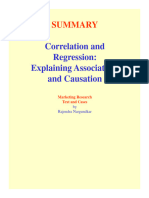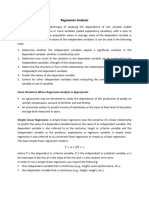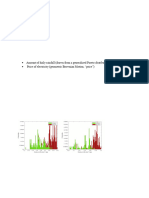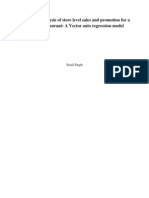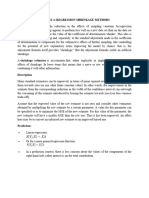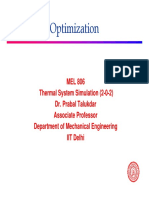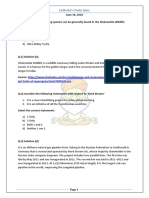Sensitivity Analysis in Linear Programming
Sensitivity Analysis in Linear Programming
Uploaded by
Pratik PatilCopyright:
Available Formats
Sensitivity Analysis in Linear Programming
Sensitivity Analysis in Linear Programming
Uploaded by
Pratik PatilOriginal Description:
Original Title
Copyright
Available Formats
Share this document
Did you find this document useful?
Is this content inappropriate?
Copyright:
Available Formats
Sensitivity Analysis in Linear Programming
Sensitivity Analysis in Linear Programming
Uploaded by
Pratik PatilCopyright:
Available Formats
10-04-2016
SENSITIVITY ANALYSIS IN LINEAR PROGRAMMING
In all LP models the coefficient of the objective function and the constraints are supplied as input
data or as parameters to the model.
The optimal solution obtained by the simplex method is based on the values of these coefficients.
In practice the values of these coefficients are seldom known with absolute certainty, because
many of them are functions of some uncontrollable parameters.
For instance, future demands, the cost of raw materials, or the cost of energy resources cannot be
predicted with complete accuracy before the problem is solved.
Hence the solution of a practical problem is not complete with the mere determination of the
optimal solution.
Each variation in the values of the data coefficients changes the LP problem, which may in turn
affect the optimal solution found earlier.
In order to develop an overall strategy to meet the various contingencies, one has to study how the
optimal solution will change with changes in the input (data) coefficients.
This is known as sensitivity analysis or post-optimality analysis.
Some data coefficient or parameters of the linear program may be controllable; for
example, availability of capital, raw material, or machine capacities. Sensitivity analysis
enables us to study the effect of changes in these parameters on the optimal solution. If it
turns out that the optimal value (profit / cost) changes (in our favor) by a considerable
amount for a small change in the given parameters, then it may be worthwhile to
implement some of these changes. For example, if increasing the availability of labor by
allowing overtime contributes to a greater increase in the maximum return, as compared
to the increased cost of overtime labor, then we might want to allow overtime production.
In many cases, the values of the data coefficients are obtained by carrying out statistical
estimation procedures on past figures, as in the case of sales forecasts, price estimates,
and cost data. These estimates, in general, may not be very accurate. If we can identify
which of the parameters affect the objective value most, then we can obtain better
estimates of these parameters. This will increase the reliability of our model and the
solution.
10-04-2016
Sensitivity analysis
Here we attempt to address issues such as:
What happens to the solution if the values of the objective
function coefficient change?
What happens when the values of RHS change?
What happens when the coefficients in the constraints
change?
What happens when we add a new variable?
What happens when we add a new constraint?
Maximize, Z=4X1+3X2+5X3
Subject to:
X1+2X2+3X39
2X1+3X2+X312
X1,X2 ,X30
4
1
2
2
3
3
1
1
0
0
1
9
12
1/3
5/3
2/3
7/3
1
0
1/3
-1/3
0
1
3
9
7/3
-1/3
-5/3
15
0
1
1/5
7/5
1
0
2/5
-1/5
-1/5
3/5
6/5
27/5
-18/5
-6/5
-7/5
138/5
RHS
0
0
5
0
5
4
The optimal solution is, X1=275, X3=65, Z=138/5.
3
12
9
27/5
10-04-2016
Changes in values of objective function coefficients
(C )
Two cases:
Changes in C value of a non basic variable.
Changes in C value of a basic variable.
Changes in
value of a non-basic variable
In our example, variable is a non-basic optimum. Let us consider changes in C
values. Let us assume a value C instead of the given value of 3. This will mean that all
alone will change. We compute
= C -33/5.
The present value of C =3 results in becoming negative. A value of C >33/5
would make
take a positive value resulting in variable X entering the basis.
Let us consider C =7. This would make
=2/5 and the variable enters the
basis. We perform simplex iterations till we reach the optimum. The present optimal
table (with modified values of C and
is shown and the subsequent iterations
are shown in table 3.11)
10-04-2016
0
RHS
5
4
5
7
0
1
1/5
7/5
1
0
2/5
-1/5
-1/5
3/5
6/5
27/5
2/5
-6/5
-7/5
138/5
-1/7
5/7
0
1
1
0
3/7
-1/7
-2/7
3/7
3/7
27/7
-2/7
-8/7
-11/7
204/7
= ,
The new optimal solution is,
Changes in
6
27/7
= 204/7.
value of a basic variable
Let us consider a change in the objective function coefficient of variable . Let us
call it . The change will affect all the non-basic values. We compute
=3-1-7 /5
= 02+
=0+13
/5
/5
For the present value of =4, the values are -18/5, -6/5 and -7/5. All the values
are negative. We also observe that for
<10/7, can become positive. For
> 10 and
>0
for >3/5,
>0.
In the range 6/5
consider
2/5 and
=12.
10, the present set of basic variable will be optimal. Let us
=3-[12x7/5+1] = -28/5,
= 1 = 31/5. Variable
iterations till it reaches the optimum.
The modified optimum (for
3.12
= 2 +
enters the basis and we perform simplex
= 12) and the final solutions are shown in Table
10-04-2016
12
0
RHS
5
12
0
12
0
1
1/5
7/5
1
0
2/5
-1/5
-1/5
3/5
6/5
27/5
-74/5 0
2/5
-31/5 354/5
0
1
3/2
5/2
1
0
-1/2
3
6
-15
-1
-6
72
Here also the optimum was found within one iteration. The optimum solution
is
= 12,
=3
= 72.
2 Changes in RHs values
For change in the RHs value, say
RHS =
.the change results in change in the RHS values.
2/5 1/5 (2
=
(2
1/5 3/5
12)/5
12)/5
(36-b1)/5
Here b, is such that (2 12)/5 and (36 )/5 are 0, the current basis will be
optimal with the values given by
= (2 12)/5 and
= (36 )/5. This
can happen when b 36. When b is outside this range, one of the RHS values
will be negative. When = 40,
values become
RHS=
2/5 1/5 40 68/5
=
1/5 3/5 12 4/5
We carry out dual Simplex iterations with the starting solution where one of the RHS
values is negative as shown in Table 3.13
10-04-2016
0
RHS
5
4
0
1
1/5
7/5
1
0
2/5
-1/5
-1/5
3/5
-18/5
-6/5
-7/5
68/5
-4/5
6
4
0
2
-5
3
-7
1
10
0
1
1
-3
12
4
-4
48
0
-4
-9
=12, = 4, = 48. This was also obtained from one
iteration from the modified simplex table.
The optimum solution is
Changes in coefficient of constraints (of a non-basic variable)
We consider change in the constraint coefficient of the non basic variable .
2
Considering, column vector corresponding to = . The corresponding column in
the optimum table will be
2/5 1/5 2
(4 )/5
=
1/5 3/5
(3 2)/5
(4 )/5
=3 - 5 4
= (3 7 )/5
(3 2)/5
If the change is such that 0 , the present solution will be optimal. If
b=1/3, then = 2/15 and variable will enter the basis. The value of the
entering column will be ,
2/5 1/5 2
11/15
=
=
=
1/5 3/5 1/3
1/5
=
10-04-2016
0
RHS
5
4
3
4
0
1
11/15
-1/5
1
0
2/5
-1/5
-1/5
3/5
6/5
27/5
2/15
-6/5
-7/5
138/5
0
1
1
0
15/11
3/11
6/11
-1/11
-3/11
6/11
18/11
63/11
-2/11
-14/11 -15/11 306/11
18/11
=18/11, = 63/11 , with Z=306/11. Here
too the optimum solution in obtained in one iteration.
The new optimum solution is given by
Adding a new product
Let us consider a new product to the problem. This is incorporated in the formulation
by the introduction of new variable . assuming this product requires1 unit of
resource 2 per product and fetches a profit of Rs. 6/unit.
This is same as verifying whether
Variable
-y
can enter the basis. Now,
=
1
and
3
=6-27/5=3/5
enters the basis. The modified optimum table is shown and the simplex
iterations are shown in the table below.
10-04-2016
6
RHS
5
4
0
X1
1/5
2/5
-1/5
7/5
-1/5
3/5
8/5
27/5
-18/5 0
-6/5
-7/5
3/5
138/5
1/8
5/8
3/8
7/8
1
0
3/8
-1/8
-1/8
3/8
0
1
15/8
27/8
-3/8
-33/8 0
-9/8
-13/8 0
-1/5 6/5
5
6
237/8
The optimum solution is given by
=15/8,
= 237/8.
Adding a New Constraint
let the new constraint be
8.
The solution = 27/5,
= 6/5 satisfies the constraint and the present solution
continues to be optimal even with the additional constraint.
If the constraint was + +
6, the present optimal solution violates the
constraint. We rewrite the constraint as an equation by adding a slack variable and
write the basic variables in terms of the non basic variables.
+ + +
=8
From the optimum Simplex table, we have
+7
/5 1
/5 + 3
/5 = 27/5
/5
/5 = 6/5
And
+1
/5 +2
Substituting we get
3
1
2
+
5
5
5
+
3
5
=6
line gayab
10-04-2016
(Observe that if the constraint is binding, as in this case, the final equation
after substitution will have a negative value of the RHS when the slack
variable has +1 coefficient). We include this constraint into the optimal
table and proceed with dual simplex iterations till the new optimum is
reached. This is shown in table below.
5
4
0
5
4
0
X1
X6
X5
0
1
0
1/5
7/5
-3/5
1
0
0
2/5
-1/5
-1/5
-1/5
3/5
-2/5
0
0
1
0
0
1
0
0
-18/5
3/2
-3/2
0
1
0
0
0
-6/5
-1/2
1/2
-1/2
-7/5
0
0
1
0
3/5
-1/2
3/2
-5/2
-7/2
RHS
6/5
27/5
-3/5
138/5
3/2
9/2
3/2
51/2
You might also like
- Taboo Erotiica Adult StoriesDocument292 pagesTaboo Erotiica Adult StoriesSika Jantunen67% (6)
- DOE in ExcelDocument30 pagesDOE in Excelmaria10018012No ratings yet
- Central Composite DesignDocument49 pagesCentral Composite DesignKalyana Manohar Veeramallu100% (1)
- Week1 QuizDocument16 pagesWeek1 QuizAbhinav BhargavNo ratings yet
- Important Percentages To Fractions Conversion List PDF For SBI PO IBPS Bank ExamsDocument3 pagesImportant Percentages To Fractions Conversion List PDF For SBI PO IBPS Bank ExamsKumar Santosh53% (19)
- PunctuationDocument8 pagesPunctuationCristinaCrisNo ratings yet
- OR Notes For MBADocument7 pagesOR Notes For MBAalakaNo ratings yet
- Correlation and Regression: Explaining Association and CausationDocument23 pagesCorrelation and Regression: Explaining Association and CausationParth Rajesh ShethNo ratings yet
- Braun Ma4 SM 09Document55 pagesBraun Ma4 SM 09nobleverma100% (1)
- Summary - Regression AnalysisDocument23 pagesSummary - Regression AnalysisSanmaan SinghNo ratings yet
- Panel Data Problem Set 2Document6 pagesPanel Data Problem Set 2Yadavalli ChandradeepNo ratings yet
- Convergence CriteriaDocument9 pagesConvergence Criteriaajota_7No ratings yet
- Introductory ExampleDocument11 pagesIntroductory ExampleChristianAslanNo ratings yet
- Linear Programming III: Duality and Sensitivity AnalysisDocument3 pagesLinear Programming III: Duality and Sensitivity Analysistejashraj93No ratings yet
- Assignment Or-211111Document6 pagesAssignment Or-211111Sanjay ChoubeyNo ratings yet
- Regression Analysis Using RDocument17 pagesRegression Analysis Using RMd. Alzadid NeeloyNo ratings yet
- Linear ProgrammingDocument6 pagesLinear ProgrammingAnkit ChoudharyNo ratings yet
- Exp FinalDocument4 pagesExp Finalhugo mendozaNo ratings yet
- Sensitivity Analysis - Linear ProgrammingDocument5 pagesSensitivity Analysis - Linear ProgrammingancNo ratings yet
- SMU Assignment Solve Operation Research, Fall 2011Document11 pagesSMU Assignment Solve Operation Research, Fall 2011amiboi100% (1)
- Student Slides Supplement 6Document15 pagesStudent Slides Supplement 6Ganessa RolandNo ratings yet
- Ch04 SolutionsDocument13 pagesCh04 Solutionskobronwade23No ratings yet
- Sensitivity AnalysisDocument20 pagesSensitivity AnalysisAman MachraNo ratings yet
- Regn & Marketing ResearchDocument23 pagesRegn & Marketing ResearchsandeepbannaNo ratings yet
- Presenting The Results From Factor AnalysisDocument2 pagesPresenting The Results From Factor AnalysisCristina ValentinaNo ratings yet
- MB0048Document12 pagesMB0048prasannasuddapalliNo ratings yet
- Step 1Document3 pagesStep 1dheerajgulati_31No ratings yet
- Nitsri Notes PDFDocument17 pagesNitsri Notes PDFTaniyaNo ratings yet
- Statistical Inference, Regression SPSS ReportDocument73 pagesStatistical Inference, Regression SPSS ReportIjaz Hussain BajwaNo ratings yet
- Problem Solving and Decision MakingDocument13 pagesProblem Solving and Decision Makingrupsanvl001No ratings yet
- 5.2 Process Capability Analysis Rev2ADocument8 pages5.2 Process Capability Analysis Rev2APollyNo ratings yet
- A Comprehensive Handout On Central Composite Design (CCD)Document48 pagesA Comprehensive Handout On Central Composite Design (CCD)opetakyNo ratings yet
- Reducing Process Variation With Statistical Engineering - SteinerDocument8 pagesReducing Process Variation With Statistical Engineering - Steinertehky63No ratings yet
- AORDocument33 pagesAORakshay adhavNo ratings yet
- Optimization in Pharmaceutics & ProcessingDocument75 pagesOptimization in Pharmaceutics & ProcessingAbdul Muheem100% (1)
- MB0048 - Operations ResearchDocument10 pagesMB0048 - Operations ResearchdeepmaniarNo ratings yet
- User Manual For Rate Time SpreadsheetDocument15 pagesUser Manual For Rate Time SpreadsheetJorge Leopoldo VeraNo ratings yet
- Nonlinear Parameter Estimation: A Case Comparison: StudyDocument17 pagesNonlinear Parameter Estimation: A Case Comparison: StudymythyanNo ratings yet
- A Parameter Set Design Procedure For The Simulated Annealing Algorithm Under The Computational Time ConstraintDocument14 pagesA Parameter Set Design Procedure For The Simulated Annealing Algorithm Under The Computational Time Constraintesraa.mansour0258No ratings yet
- L 10 Principal Component Analysis 09052024 072206pmDocument37 pagesL 10 Principal Component Analysis 09052024 072206pmBahadar AyazNo ratings yet
- project_reportDocument8 pagesproject_reportSwar PandNo ratings yet
- VAR ProjectDocument13 pagesVAR Projectsunils05No ratings yet
- Six Sigma Vs TaguchiDocument14 pagesSix Sigma Vs TaguchiemykosmNo ratings yet
- Linear Programming ProblemDocument13 pagesLinear Programming Problemraj100% (1)
- Spreadsheet Determines Hyperbolic-Decline Parameters - Oil & Gas JournalDocument5 pagesSpreadsheet Determines Hyperbolic-Decline Parameters - Oil & Gas JournalWassef MBNo ratings yet
- Chi SquareDocument5 pagesChi SquarekglorstadNo ratings yet
- Module 4: Regression Shrinkage MethodsDocument5 pagesModule 4: Regression Shrinkage Methods205Abhishek KotagiNo ratings yet
- EDA 4th ModuleDocument26 pagesEDA 4th Module205Abhishek KotagiNo ratings yet
- GB Paper Imi - 1 Sep 2013 ManishDocument16 pagesGB Paper Imi - 1 Sep 2013 ManishManish KumarNo ratings yet
- Process Optimization in Chemical EngineeringDocument27 pagesProcess Optimization in Chemical EngineeringOx AntonioNo ratings yet
- Single Response: Optimization When There Is Adequate Quadratic FitDocument7 pagesSingle Response: Optimization When There Is Adequate Quadratic FitLazaro CoutinhoNo ratings yet
- Simulated Annealing: Basics and Application ExamplesDocument13 pagesSimulated Annealing: Basics and Application ExamplesRicardo Alejos100% (1)
- And Another OneDocument9 pagesAnd Another OneSandeep RaiNo ratings yet
- CP, CPK, PP and PPKDocument21 pagesCP, CPK, PP and PPKck_pey100% (1)
- Powerful Forecasting With MS Excel SampleDocument257 pagesPowerful Forecasting With MS Excel SampleBiwesh NeupaneNo ratings yet
- Test of AnnovaDocument37 pagesTest of AnnovaTina MillerNo ratings yet
- Important Percentages To Fractions Conversion List PDF For SBI PO IBPS Bank Exams PDFDocument3 pagesImportant Percentages To Fractions Conversion List PDF For SBI PO IBPS Bank Exams PDFKumar Santosh100% (1)
- Moderation Meditation PDFDocument11 pagesModeration Meditation PDFMostafa Salah ElmokademNo ratings yet
- (16 17) OptimizationDocument29 pages(16 17) OptimizationSSNo ratings yet
- ME 310 LAB End-Semester Exam - 24 April 2015: Batch 1 (2PM)Document5 pagesME 310 LAB End-Semester Exam - 24 April 2015: Batch 1 (2PM)Pratik PatilNo ratings yet
- Iasbaba'S Daily Quiz: Get-Fruits-Of-Mgnrega/Article27699541.EceDocument4 pagesIasbaba'S Daily Quiz: Get-Fruits-Of-Mgnrega/Article27699541.EcePratik PatilNo ratings yet
- Proportionat or BiologicalDocument20 pagesProportionat or BiologicalPratik PatilNo ratings yet
- Contain PageDocument1 pageContain PagePratik PatilNo ratings yet
- ME 310 LAB End-Semester Exam - 24 April 2015: Batch 1 (2PM)Document5 pagesME 310 LAB End-Semester Exam - 24 April 2015: Batch 1 (2PM)Pratik PatilNo ratings yet
- European Money Market Funds - A Primer For Investors: Questions and Answers - Part 2Document6 pagesEuropean Money Market Funds - A Primer For Investors: Questions and Answers - Part 2Pratik PatilNo ratings yet
- Omerović, Enes S. Političko Nasilje U BiH (1918-1921)Document282 pagesOmerović, Enes S. Političko Nasilje U BiH (1918-1921)Enes S. OmerovićNo ratings yet
- Christmas Script 2024-2025Document3 pagesChristmas Script 2024-2025Erry Nurmalasari100% (1)
- Software Cost EstimationDocument58 pagesSoftware Cost EstimationMmNo ratings yet
- Consciousness Review SheetDocument2 pagesConsciousness Review Sheetapi-472831614No ratings yet
- Hidden Errors in Turbine Blade Moment Measurement and How To Avoid ThemDocument24 pagesHidden Errors in Turbine Blade Moment Measurement and How To Avoid ThemThanaraj SanmughamNo ratings yet
- Price Action Part 2Document41 pagesPrice Action Part 2imad ali100% (2)
- Enjela Estefani ManurungDocument15 pagesEnjela Estefani ManurungRein SiraitNo ratings yet
- Processing of Persuasive In-Group MessagesDocument11 pagesProcessing of Persuasive In-Group MessagesJoyce TanNo ratings yet
- Abbreviations Quick Guide: 7th EditionDocument2 pagesAbbreviations Quick Guide: 7th EditionMelaniekleineNo ratings yet
- Be It 4 Sem Engineering Mathematics 3 Jun 2018Document5 pagesBe It 4 Sem Engineering Mathematics 3 Jun 2018M TyBNo ratings yet
- Presented By: Amit Pandit: Pranay Gehlot Yash Raj SoniDocument29 pagesPresented By: Amit Pandit: Pranay Gehlot Yash Raj SoniPranay GehlotNo ratings yet
- Iso 6976Document1 pageIso 6976Waleed El-azabNo ratings yet
- Unit 1B: Non Native Speakers Spanish 1 PROJECT OVERVIEW: IndividuallyDocument3 pagesUnit 1B: Non Native Speakers Spanish 1 PROJECT OVERVIEW: Individuallyapi-26436085No ratings yet
- Microsoft Office 2016 - Key InstallationDocument1 pageMicrosoft Office 2016 - Key InstallationHaliryNo ratings yet
- Physics PracticalDocument24 pagesPhysics PracticalPeddini Pradeep KumarNo ratings yet
- The Perceived Success of Interventions in Science EducationDocument54 pagesThe Perceived Success of Interventions in Science EducationBernadette PalamianoNo ratings yet
- Fardaic CurrentDocument7 pagesFardaic CurrentlecturioNo ratings yet
- Mental HealthDocument39 pagesMental HealthBaby ZoeNo ratings yet
- NOUNS - AbridgedDocument41 pagesNOUNS - AbridgedmiaNo ratings yet
- Professional Development PowerpointDocument10 pagesProfessional Development Powerpointapi-549073507No ratings yet
- Third-Party ComplaintDocument4 pagesThird-Party ComplaintAdriano Bahian Jr.100% (1)
- The Paradox of International Justice Compliance Jelena Suboti CDocument22 pagesThe Paradox of International Justice Compliance Jelena Suboti CJulliette LlorenNo ratings yet
- How I Met Your Mother - 3x05 - How I Met Everyone Else - enDocument35 pagesHow I Met Your Mother - 3x05 - How I Met Everyone Else - enHTK_03No ratings yet
- Package Ineq': R Topics DocumentedDocument17 pagesPackage Ineq': R Topics DocumentedAan SetyawanNo ratings yet
- Smaller and Smaller Circles 1Document4 pagesSmaller and Smaller Circles 1Andrew RamosNo ratings yet
- Mou Queensland JatengDocument8 pagesMou Queensland Jatengkwonmin817No ratings yet
- Mitral Stenosis Case PresentationDocument7 pagesMitral Stenosis Case PresentationOM BAWNENo ratings yet
- Uthala Cremation: 10Th Day KriyaDocument1 pageUthala Cremation: 10Th Day Kriyakumaranupam_gauravNo ratings yet









